| Wecome to the Tour... | ||
| You are welcome to
have a look around my small collection of telephones. I'm a telephone
enthusiast rather than a collector, so you will not find "one
of everything", just items which have taken my fancy. Hopefully
you will find something interesting. For more information on the system and how it is configured see the System page. |
||
|
Porch. This is a Siemens 311 wall 'phone. It is the wall equivalent of the 200 series telephones, but it was never adopted by the British Post Office. They were made in
the UK and this one was exported to Canada. |
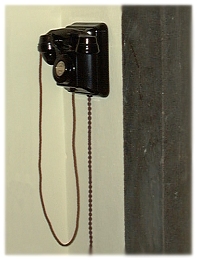
|
|
|
|
||
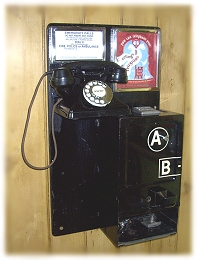
|
Kitchen. This is my Renters A+B Box. |
|
|
This is a bell 1A which is slightly shorter than the bellset 1 and contains only the bell mechanism. |
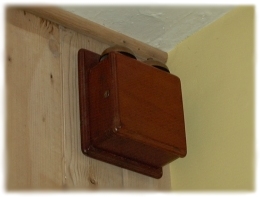
|
|
|
|
||
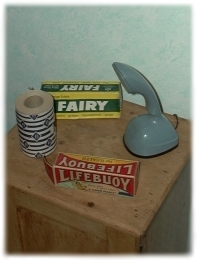
|
Bathroom. This is an example of the highly collectible Ericofon. |
|
|
|
||
|
Inner Hall. On the wall is a rather nice GEC wall phone. It it is part of a private intercom system and I was told it came out of a solicitor's office in Preston. I
had the chance of buying a pair at £12 each, but being a student I could only afford one... |
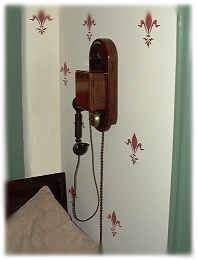
|
|
|
|
||
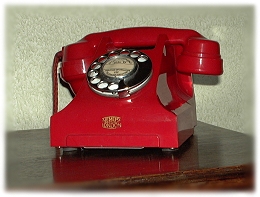
|
Living Room. On the left is my only coloured thermo-set plastic phone. These are actually made of Urea Formaldehyde rather than bakelite. This is a Siemens model 356. It was supplied for use on a private system. This is a lovely example and has hardly had any use. It still has it's original cords - the line cord is plaited and the handset cord is braided. It also retains the gold "Siemens Brothers London" transfer on the front. |
|
|
Here is my Tele 150 (candlestick) telephone complete with it's Bellset No 1. This telephone has been factory modified from a Tele 2. The unit next to it is an
Autodial No.1. This was used by the busy secretary to dial pre-programmed numbers by lifting the reciever, selecting the number to dial and pressing the lever. This one dates from 1933. |
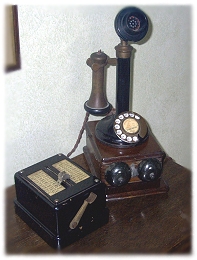
|
|
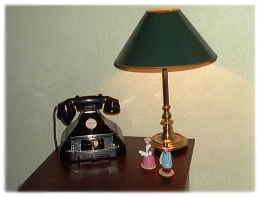
|
This is a Tele 248 complete with Bellset 44. This combination was used on GPO "Plan 7" extension systems. Typically this would be a manager / secretary scenario. The
secretary would have the main phone and the manager would have the extension. |
|
|
This is a Tele 330CB with "Call Main" button. This is the extension telephone which works alongside the above "Plan 7" main station. Pressing the button rings the buzzer in the main station. Pressing the button on the main station rings the d.c. bell attached to the extension. This system is fully operational, but it is not possible to use electronic transmitters as the 4.5V speech battery will not power them. |
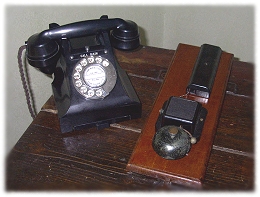
|
|
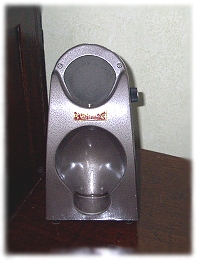
|
This is a Fonadek unit. The idea is that you place a 164 type handset on the Fonadek and make a call as normal. The Fondek amplifies the received signal and speech is heard
through a loudspeaker. |
|
|
The above three telephones are all connected as extensions on my CB935 1+3 PMBX. If you want to ring an extension you depress the relavent key (bottom row) and wind the magneto
handle on the right side of the case. |
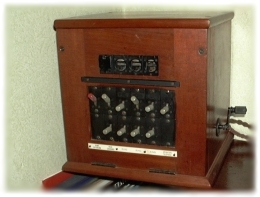
|
|
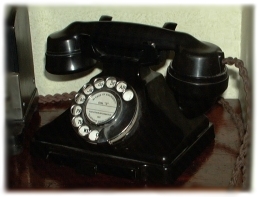
|
This is the operators telephone (a Tele 232) which is used in conjunction with the PMBX above. The dial can be used to place external trunk calls. |
|
|
This unit sits alongside the operator phone and the PMBX. It was invented by Donald Macadie and is known as a Keysender No 5. It allowed operators to
dial numbers quicker than they could with an ordinary dial. It is an amazing mechanism as you can dial really quickly and it "remembers" what you have dialed and carries on pulse dialing at the standard rate. I suppose this is the
predecessor of all push-button phones. |
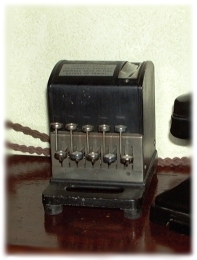
|
|

|
My A+B button coin collection box is temporarily located in the living room. This one is from Ireland and originally had no internal bell. - I have now fitted a bellset 33. |
|
|
This is a Tele 238. This telephone was specifically for use with CCBs like the one above. It is fitted with a modified dial which only allows "0" (the Operator) or
"9" (i.e. 999) to be dialled initially by the caller without inserting money into the CCB. |
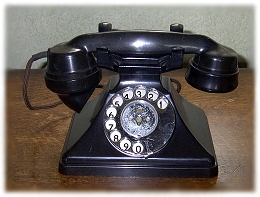
|
|
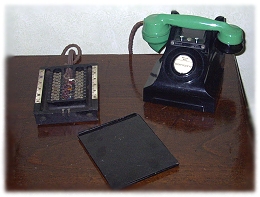
|
This is my "Scrambler" telephone. I am slowly acquiring more information about this phone. Luckily it still has its original connection box. It dates from 1945. See News & projects page for more information. |
|
|
|
||
|
Main Bedroom. This is an Ericsson 1000 series telephone. Never adopted by the GPO (they were busy developing the 706) it was used on private systems. All bakelite, it is
more rounded than the 300 series. |
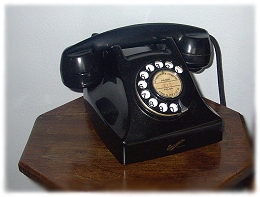
|
|
|
|
||
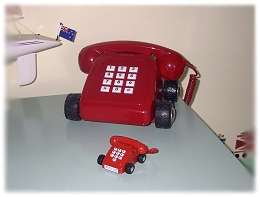
|
Christopher's Room. Christopher has a red "Direct Line Insurance" telephone in his room. In front of the real phone is a matchbox toy phone which rings like the advert when the buttons are pressed. |
|
|
|
||
|
Spare Room. This is the telephone which got me interested in phones - an 8756. The 756 was based on a 746 with the addition of push-buttons to replace the dial. The 8 prefix means it left the factory with the new plug-in jack. |
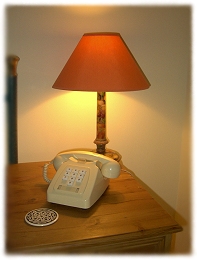
|
|
|
|
||
| Press button |

|
for homepage |